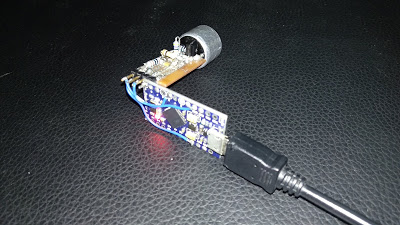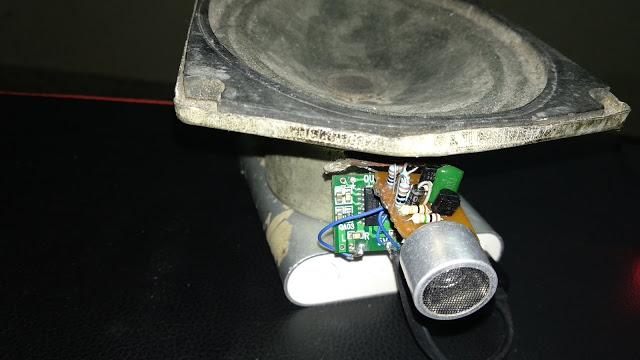Sound transmission by amplitude modulation of ultrasound
- Transfer
- Tutorial

A simple sound transmission system with amplitude modulation of ultrasound consists of a transmitter and a receiver. In the transmitter, the Arduino Pro Micro emulates a sound card with a USB interface and generates two signals: output 5 - an audio signal, which is then cleared from the PWM by an RC filter, and output 9 - a carrier frequency of 40 kHz. Both signals are fed to a single-transistor stage, parallel to the load resistor of which an ultrasonic transducer is connected from the range finder.

In the receiver, the same ultrasonic transducer converts the acoustic signal back to electric, then everything is done the same as in the direct amplification radio receiver: UHF, detector and preliminary VLF. The power amplifier is the standard PAM8403 module.


To implement the emulation of a sound card with a USB interface, the LuFA library was required, so instead of Arduino IDE it was necessary to use avr-gcc. To upload the firmware (lies here ), it is necessary to reset the Arduino in hardware, which is why it will go into USB bootloader mode for a few seconds. During this time, you need to have time to start pouring with avrdude.
To set up the device, you first need to use an oscilloscope to verify that there is no overmodulation and no limitation:


Having eliminated both by decreasing the volume and selecting resistors in the transmitter, you need to connect the oscilloscope to the output of the UHF receiver, and in the transmitter, set the PWM frequency (software) in the range from 38 to 42 kHz so that it matches the resonant frequency of the converters. The author recommends experimenting with the introduction of an AGC system into the receiver, similar to that used in conventional AM radio receivers.
So everything works after commissioning:
You can program the Arduino in the usual way by assigning only carrier generation to the firmware, and do without it at all by implementing a 40-kilohertz generator in hardware. At the same time, an audio signal can be fed directly to the modulator, and the RC filter becomes unnecessary.
